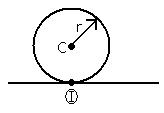 |
||||||||
 |
 |
 |
 |
|||||
 |
||||||||
 |
||||||||
 |
 |
|||||||
 |
||||||||
 |
||||||||
 |
||||||||
 |
||||||||
 |
||||||||
PRINCIPLE OF WORK AND ENERGY EXAMPLES
WORK FOR AN INSTANTANEOUS CENTER
For a rolling circular body, as seen in Figure 1↑, where the velocity of the center VC is moving along one axial direction (VC = VCi), where IC is the moment of inertia about point C, and m is the mass of the body.
The rate of change of kinetic energy is equivalent to power: P = KĖ. The power for this case can be integrated to get the work done on the body:
where external work equals the change in kinetic energy ΔKE.
These calculations assume that the body MUST be rigid (the body does not deform or bend).
WORK FOR A CONTACT POINT
For Figure 2↑, the following steps can be taken to compute the work, W.
- For a constant F1 value, W = ∫F1V1dt = F1∫V1dt
- F1 is a gravity force and acts on P1. Therefore, F1 = cos(α)mg.
- At the contact point, W = ∫F1V1dt = 0. The normal reaction force, F1, always does no work when it is perpendicular to the point of contact.
- Vp = 0 at the point of contact. Therefore, W = ∫F1Vpdt = 0.

